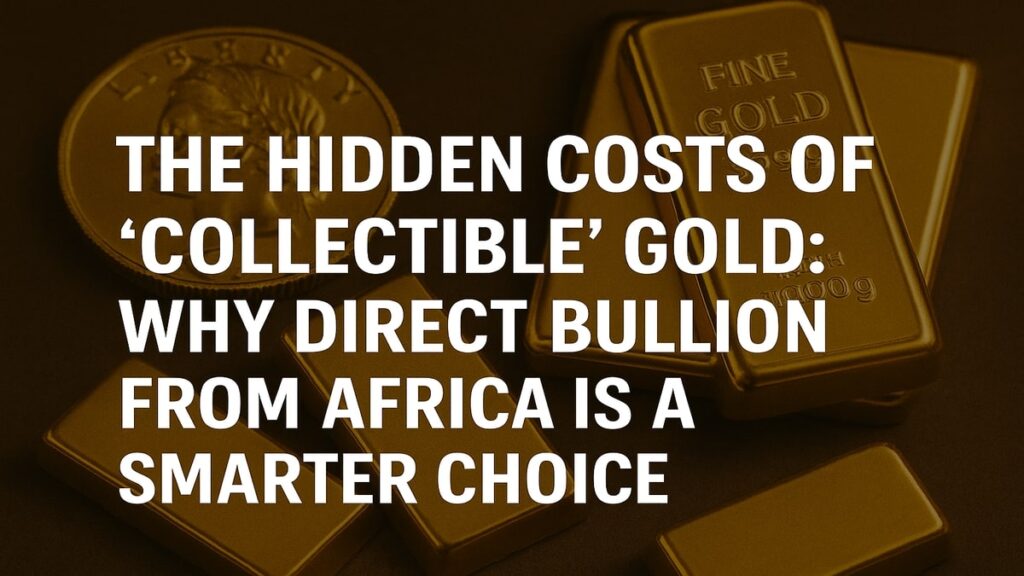Gold is gold — or at least, it should be. Yet across global markets, investors are routinely overpaying for “collectible” gold coins, jewelry pieces, and branded bullion products. Behind the glossy packaging and limited-edition labels lie hidden premiums that eat away at long-term value.
For savvy buyers, the smarter move is to skip the middlemen and source bullion direct from the mine. At Congo Rare Minerals (CRM), we deliver DRC gold at near-mine prices — transparent, certified, and free of retail markups.
This article breaks down the hidden costs of collectible gold and shows why direct bullion from Africa’s richest mines is the strategic choice for serious investors.
1. The Collectible Gold Trap: Paying for Packaging, Not Value
- Luxury premiums – Branded gold coins and bars (from mints or luxury houses) often carry 10%–20% above spot due to “collectibility.”
- Jewelry markup – Retail jewelry can command 50%+ above melt value, driven by brand positioning, marketing, and design fees.
- Dealer spreads – Middleman bullion dealers typically add $30–$60 per ounce in premiums, regardless of true scarcity.
💡 World Gold Council data confirms that premiums on collectible coins far outpace bullion margins, eroding ROI for investors.
2. What Investors Really Want: Pure, Liquid, Recognizable Bullion
At the end of the day, gold is judged by three qualities:
- Purity – Is it certified and assay-backed?
- Liquidity – Can it be sold anywhere, instantly?
- Cost Efficiency – How close is it to spot price?
The packaging, engraving, or “limited edition” story doesn’t change liquidity. It just drains investor capital into premiums that don’t hold resale value.
3. How Congo Rare Minerals Eliminates Hidden Costs
At CRM, our model is brutally simple: mine-direct gold bars from the DRC, sold at minimal markups.
- Near-Mine Pricing – Our bars are often $2,000–$3,000 per kilo cheaper than Western retail gold.
- Certified & Traceable – LBMA-compliant certificates + SGS assays.
- Scalable Allocations – From 100g bars to tonne-level deliveries.
- No Middlemen – Sourced directly from DRC mines, not resold through dealers.
- Global Vault Access – Delivery into Zurich, Dubai, Kampala, or directly into client custody.
👉 This means more ounces for your dollar — and a position that compounds stronger over time.
4. The Direct-from-Africa Advantage
Why Congo? Because the DRC is:
- Home to $24 trillion in untapped mineral reserves, including some of the world’s purest gold deposits.
- Expanding formal traceability systems (CEEC’s e-trace) to ensure compliant exports.
- Building strategic trade links with Dubai, Europe, and Asia — boosting liquidity of Congolese gold.
With Congo Rare Minerals, investors bypass collectible fluff and buy gold at the source — where costs are lowest and value is highest.
5. Comparing Collectible Gold vs. CRM Bullion
| Feature | Collectible / Branded Gold | CRM Mine-Direct Bullion |
|---|---|---|
| Premium Above Spot | 10–50% | 1–3% |
| Purity | Variable (some <99.9%) | 99.9% LBMA-certified |
| Liquidity | Lower (dependent on collector demand) | High (global resale ready) |
| Traceability | Often unclear | SGS-assayed, mine-direct |
| Resale ROI | Weak | Stronger (close to spot) |
✅ Key Takeaways
- Collectible gold = expensive packaging, weak resale value.
- Congo Rare Minerals = mine-direct bullion, low premiums, high liquidity.
- The smart investor knows: ounces matter more than engraving.
Conclusion
In today’s investment climate, efficiency beats branding. Collectible gold might look impressive, but its resale value is eroded by massive markups.
By sourcing bullion direct from the DRC with Congo Rare Minerals, investors secure pure, traceable, near-mine gold at true market value.
Next Step: Compare Collectible Gold to CRM Bullion → – See how much more metal your money buys.

